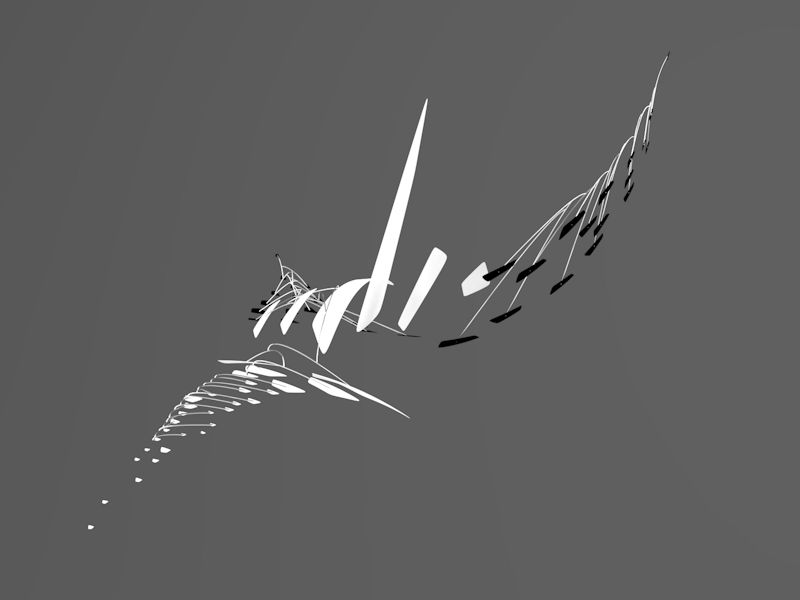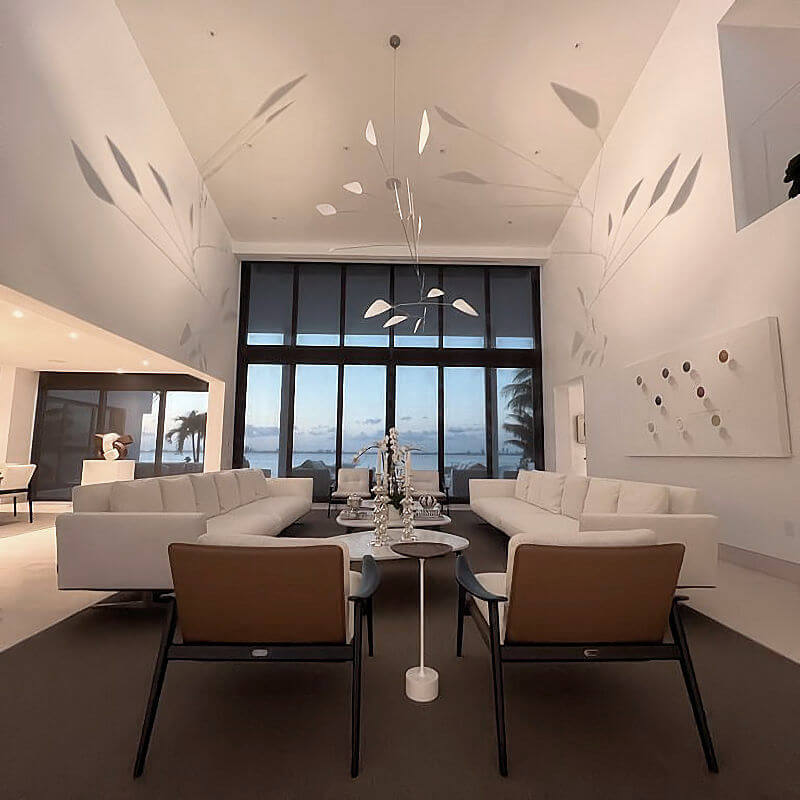Welcome!
I’m a kinetic sculptor specializing in mobiles. I design and make a wide variety of mobiles, from smaller fine art sculptures to large custom-made mobiles. In style, my work ranges from Constructivism and Calder-inspired mid-century modern to Deconstructivism (with hints of Futurism), as well as original and contemporary designs.
My artwork has been featured at New York Fashion Week in Bryant Park and, in 2015, I won 3rd Prize at the International Kinetic Art Competition, organized by KAO, the largest kinetic art and sculpture organization in the world. I made a 33-foot mobile for a commission I won in which I competed against 22 sculptors including Zaha Hadid. In a collaboration with mathematician Henry Segerman, we created the first fully 3D-printed mobiles. The movie The Upside (2019, starring Bryan Cranston, Kevin Hart, and Nicole Kidman) features a large custom mobile prominently throughout the film, designed in collaboration with director Neil Burger, and my custom mobiles were also featured in HBO’s And Just Like That… (in both Season 2 and 3, 2023–2025). I’ve created large-scale installations for prominent architectural spaces, including a two-part custom mobile for the soaring atrium of the 105,000 sq ft Learning Commons at Kettering University (2022), as well as a custom mobile for former Yale School of Architecture dean Robert A.M. Stern at the prestigious 2017 Kips Bay Decorator Show House.
For more, please see my About page.
Thanks for stopping by,
Marco
_______________________________
THREE-DIMENSIONALLY DESIGNED MOBILES:
LARGE CUSTOM-MADE MOBILES:
CONTEMPORARY MOBILES:
MID-CENTURY MODERN MOBILES:
3D-PRINTED MOBILES:
KINETIC SCULPTURES:
ACRYLIC GLASS MOBILES:
EARLY WIRE MOBILES:
Wondering what these things are you’re looking at? They are mobiles, as in art, a type of sculpture based on balance and characterized by the ability to move when propelled by air currents, by touch, or by a small motor at any one time. The most striking feature of the mobile is that, unlike traditional sculpture, it achieves its artistic effect through movement. The balance structure of most mobiles is essentially a suspended whippletree mechanism. Mobiles are the most familiar form of kinetic art, which requires movement of some kind.
A typical mobile consists of a group of shapes, frequently abstract, that are connected by wires, string (often nylon thread), metal rods, hollow aluminum tubes, swivels or the like. The shapes are usually made of sheet metal, wood, plastic, glass, acrylic glass (Plexiglass), foam, paper, or hollow honeycomb-type structures. Mobiles are usually suspended, in most cases hanging from a ceiling or a ceiling structure, and sometimes, although much less common, from structures mounted to walls. Some mobiles are designed to stand on the ground or a platform, and are sometimes mistakenly labeled as “stabiles”. Stabiles, a term coined by Jean Arp, are large scale stationary abstract sculptures developed by Alexander Calder, usually made of bolted metal plates, that have contributed significantly to the concept of public art. Calder explained the difference between stabiles and mobiles this way: “You have to walk around a stabile or through it – a mobile dances in front of you.” George Rickey noted in 1962: “It is in the stabiles that Calder is most free, most serious, most the sculptor, and very possibly most durable.” All mobiles, hanging or standing, are a genre of kinetic sculptures, the term “kinetic” meaning “moving” or “in motion”.
Suspended kinetic sculptures have probably been around since prehistoric times in the form of wind chimes. Evidence of them has been found that proves they existed in ancient China, Japan and Rome. There are traditional mobiles made of straw called “Himmeli” from Finland and Sweden and I’ve come across a mobile made in 1751. The Russian artists Naum Gabo, Aleksandr Rodchenko and Vladimir Tatlin are credited with experimenting with hanging kinetic sculptures as an art form first in the late 1910s as part of their explorations of Constructivism. Man Ray made the first mobile out of coat hangers in 1920 that’s based on the whippletree mechanism. He also experimented with hanging abstract pieces of sheet metal. Bruno Munari started to create his own early version of mobiles in the late 1920s which he called “Useless Machines”. However, mobiles, the way we know them today as a modern art form, were mostly developed by the American sculptor Alexander Calder (influenced by the abstract work of Piet Mondrian, Joan Miró and Sophie Taeuber-Arp) beginning in the 1930s. In a 1962 interview he said: “The mobiles started when I went to see Mondrian [in October 1930]. I was impressed by several colored rectangles he had on the wall. Shortly after that I made some mobiles; Mondrian claimed his paintings were faster than my mobiles.” The name “mobile”, a French pun meaning both “mobile” and “motive”, was given to them by the artist and master inventor of Dada, Marcel Duchamp, a friend of Calder’s, although he apparently already used the term in the context of his Large Glass project (1912–15 notes; executed 1915–23), where it described a moving component tied to his exploration of the spatial fourth dimension.
Also see my History of Mobiles and Mobile Sculpture Artists – A History of Mobiles (Part 2).







